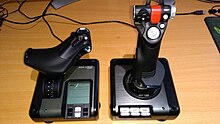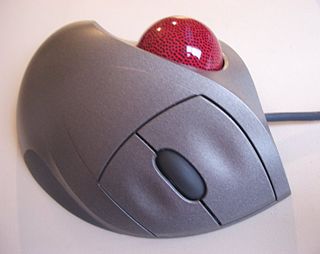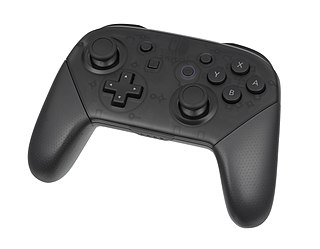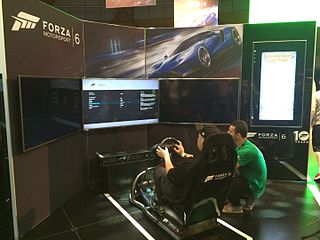
The Saitek X52 is an advanced HOTAS joystick/throttle combination from Saitek released in 2004. [1]

The Saitek X52 is an advanced HOTAS joystick/throttle combination from Saitek released in 2004. [1]
The X52 was one of Saitek's flagship products and features both a joystick and a throttle. The distinguishing feature of the X52 is the large backlit blue (or green, on an X52 Pro) LCD display on the throttle, which displays the mode it is configured, the name of the button being depressed and a chronograph function. [2] The Multi-Function Display (MFD) screen can be used to check programmed command names and use the clock and stopwatch function for timing the legs of your flight plan.
The joystick/throttle combination includes a number of controls, including trim wheels, a thumb operated slider, a mouse control and three eight-way hat switches, and a button under a flip-guard labeled "Safe". The stick includes built in yaw/rudder control, which can be disabled in the case that the user has an alternate rudder control.
The stick/throttle combination are designed to function as a HOTAS system. This means that games can be played without the player ever taking their hands off the controls to use a keyboard or mouse.
The X52 uses only a single spring mounted vertically to keep it centered, while the X52 Pro uses dual springs for stronger centering. This enables quick direction changes on the stick without "clicking" through the axes - a problem common to other sticks which normally feature two springs mounted horizontally. The X52 also features an integrated mouse on the throttle, however it is difficult to use for making quick selections and only functions when drivers and the SST software are installed.
Featuring 23 buttons, three 8-way hat switches and 7 control axes, the X52 gives you 47 basic commands plus the control axes. But when you include the programming options provided by powerful Saitek Smart Technology programming software, which allows you to make use of the 3 position mode switch and Pinkie shift switch, the total number of programmable commands is 282.
The Smart Technology (ST) programming software is used to program all kinds of behaviors for each command of the HOTAS, even custom ones such as setting not only the Pinkie switch, but just about any button to act as a shift, making it possible, then, to have multiple shift buttons configured per game Profile, which raise the total number of programmable commands far above the canon limit of 282.
Furthermore, the ST programming software allows gamers to configure their controls to suit their preferred gaming style and to save the configurations as personal game Profiles, which can be selected and applied on-the-fly at any time through the HOTAS itself (the MFD will list the available Profile names). The use of multiple game Profiles prepared for each game raises the amount of programmable functions per game to a virtually unlimited amount. This enviable feature is, at present, not found in other HOTAS devices.
Since the acquisition of Saitek in September 2016, Logitech has been providing both Driver and ST programming software support for the X52 and X52 Pro HOTAS devices. Over the years, however, users have reported issues and stability problems regarding the use of Logitech's ST programming software. The old Saitek's Driver and ST programming software are still available at ftp.saitek.com (freely accessible through most FTP clients) and they still work properly today on modern operating systems, such as Windows 10.
Please note: should the user of Logitech's Driver/ST programming software wish to revert to the Saitek's counterparts, a complete removal of the Logitech's Driver/ST programming software plus all related X52 peripherals installed in the System would be mandatory. Failing to do so would prevent the Saitek version of the ST programming software from recognizing the HOTAS, on account of different Hardware IDs imposed by Logitech's Driver. Therefore, to successfully use the ST programming software from Saitek is necessary to also use the companion driver from Saitek.

A computer mouse is a hand-held pointing device that detects two-dimensional motion relative to a surface. This motion is typically translated into the motion of the pointer on a display, which allows a smooth control of the graphical user interface of a computer.

A joystick, sometimes called a flight stick, is an input device consisting of a stick that pivots on a base and reports its angle or direction to the device it is controlling. A joystick, also known as the control column, is the principal control device in the cockpit of many civilian and military aircraft, either as a centre stick or side-stick. It has various switches to control functions of the aircraft controlled by the Pilot and First Officer of the flight.

A trackball is a pointing device consisting of a ball held by a socket containing sensors to detect a rotation of the ball about two axes—like an upside-down ball mouse with an exposed protruding ball. Users roll the ball to position the on-screen pointer, using their thumb, fingers, or the palm of the hand, while using the fingertips to press the buttons.

A game controller, gaming controller, or simply controller, is an input device or input/output device used with video games or entertainment systems to provide input to a video game. Input devices that have been classified as game controllers include keyboards, mice, gamepads, and joysticks, as well as special purpose devices, such as steering wheels for driving games and light guns for shooting games. Controllers designs have evolved to include directional pads, multiple buttons, analog sticks, joysticks, motion detection, touch screens and a plethora of other features.

Microsoft SideWinder was the general name given to the family of digital game controllers developed by Microsoft for PCs. The line was first launched in 1995. Although intended only for use with Microsoft Windows, Microsoft SideWinder game controllers can also be used with macOS, Mac OS 9 with third-party software, and Linux.

The game port is a device port that was found on IBM PC compatible and other computer systems throughout the 1980s and 1990s. It was the traditional connector for joystick input, and occasionally MIDI devices, until made obsolete by USB in the late 1990s.

A gamepad is a type of video game controller held in two hands, where the fingers are used to provide input. They are typically the main input device for video game consoles.

HOTAS, an acronym of hands on throttle-and-stick, is the concept of placing buttons and switches on the throttle lever and flight control stick in an aircraft cockpit. By adopting such an arrangement, pilots are capable of performing all vital functions as well as flying the aircraft without having to remove their hands from the controls.

A D-pad is a flat, typically thumb-operated, directional control. D-pads are found on nearly all modern gamepads, handheld game consoles, and audiovisual device remote controls. Because they operate using four internal push-buttons, the vast majority of D-pads provide discrete, rather than continuous, directional options—typically limited to up, down, left, and right, and sometimes offering intermediate diagonals by means of two-button combinations.
Saitek is a designer and manufacturer of consumer electronics founded in 1979 by Swiss technologist Eric Winkler. They are best known for their PC gaming controllers, mice, keyboards, and their numerous analogue flight controllers such as joysticks, throttles, and rudder pedals.
Various accessories for the PlayStation 3 video game console have been produced by Sony and third-party companies. These include controllers, audio and video input devices like microphones, video cameras, and cables for better sound and picture quality.

The Logitech Driving Force GT is a racing wheel peripheral designed for racing games on the PlayStation 2, PlayStation 3, and Microsoft Windows and Linux PCs. It is manufactured and distributed by Logitech International S.A of Romanel-sur-Morges, Switzerland. The wheel was released on December 13, 2007.

In computing, an input device is a piece of equipment used to provide data and control signals to an information processing system, such as a computer or information appliance. Examples of input devices include keyboards, computer mice, scanners, cameras, joysticks, and microphones.

A sim racing wheel is a control device for use in racing games, racing simulators, and driving simulators. They are usually packaged with a large paddle styled as a steering wheel, along with a set of pedals for the accelerator, brake, and clutch, as well as transmission controls. An analog wheel and pedal set such as this allows the user to accurately manipulate steering angle and pedal control that is required to properly manage a simulated car, as opposed to digital control such as a keyboard. The relatively large range of motion further allows the user to more accurately apply the controls. Racing wheels have been developed for use with arcade games, game consoles, personal computers, and also for professional driving simulators for race drivers.
VRPN is a device-independent, network-based interface for accessing virtual reality peripherals in VR applications. It was originally designed and implemented by Russell M. Taylor II at the Department of Computer Science of the University of North Carolina at Chapel Hill. VRPN was maintained and supported by Sensics while it was business. It is currently maintained by ReliaSolve and developed in collaboration with a productive community of contributors. It is described more fully at vrpn.net and in VRPN-VRST.

Logitech Harmony is a line of remote controls and home automation products produced by Logitech. The line includes universal remote products designed for controlling the components of home theater systems and other devices that can be controlled via infrared, as well as newer smart home hub products that can be used to additionally control supported Internet of things (IoT) and Smart home products, and allow the use of mobile apps to control devices. On April 10, 2021, Logitech announced that they would discontinue Harmony Remote manufacturing.

The Atari joystick port is a computer port used to connect various gaming controllers to game console and home computer systems in the 1970s to the 1990s. It was originally introduced on the Atari 2600 in 1977 and then used on the Atari 400 and 800 in 1979. It went cross-platform with the VIC-20 in 1981, and was then used on many following machines from both companies, as well as a growing list of 3rd party machines like the MSX platform and various Sega consoles.

The Atari CX40 joystick was the first widely used cross-platform game controller. The original CX10 was released with the Atari Video Computer System in 1977 and became the primary input device for most games on the platform. The CX10 was replaced after a year by the simpler and less expensive CX40. The addition of the Atari joystick port to other platforms cemented its popularity. It was the standard for the Atari 8-bit family of home computers and was compatible with the VIC-20, Commodore 64, Commodore 128, MSX, and later the Atari ST and Amiga. Third-party adapters allowed it to be used on other systems, such as the Apple II, Commodore 16, TI-99/4A, and the ZX Spectrum.